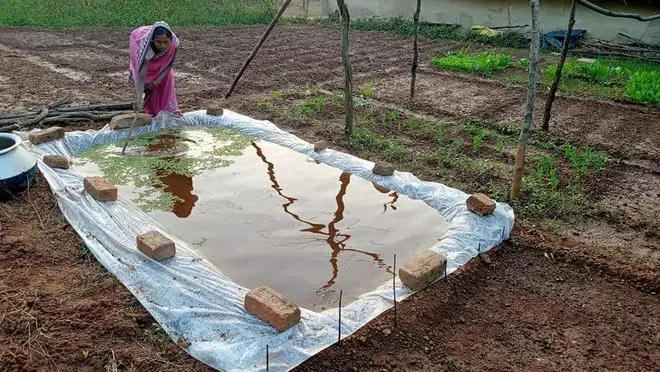The uneven single-lane road which leads you to Nawadi Sasari from Lohardaga ends abruptly, in the middle of nowhere. If you gaze continuously at the endless woodland in front, you could see a few houses probably a kilometre away. In the blazing Jharkhand sun, you’d rather not choose to walk, but manoeuvre a vehicle through a thorny terrain to reach Anita Devi’s house.
The house is a long room, divided into three sections — a kitchen, a seating area which can accommodate four people, sitting cross-legged on the unpolished floor and a passage where the family sleeps. They eat two meals a day, mostly rice and salt, for that is all that they get for free from the ration shop, upon producing their ‘Below Poverty Line’ card. Devi’s is an ultra-poor household, which according to the World Bank, “eats below 80 per cent of their energy requirements despite spending at least 80 per cent of income on food.”
Her husband has been away for a few months, working as a seasonal manual labour in a coal mine, in a neighbouring district. Devi did not accompany him because, currently, she is enrolled in the Bengaluru-based NGO Nudge Institute’s End Ultra Poverty Program (EUP), with 5,169 other women from various districts of Jharkhand.

A member of the EUP farming feed for the livestock
According to the Social Economic Caste Census 2011, India has 23 million households living in extreme poverty. There are 8 States where 70 per cent of India’s ultra-poor live, and Jharkhand is one of them. While the programme was piloted in Jharkhand in 2019, 400 women graduated from the programme in 2022. The programme is implemented in hamlets in three districts in Jharkhand — Lohardaga, Latehar and Gumla.
Nudge’s programme follows the graduation approach to poverty alleviation. Now what exactly is the graduation approach? In their research paper published in the Science magazine, a group of economists, including Abhijit Banerjee and Esther Duflo say that it “targets the poorest members in a village and provides a productive asset grant, training and support, life skills coaching, temporary cash consumption support and typically access to savings accounts and health information or services.” As part of their intervention, Banerjee’s group conducted trials in Ethiopia, Ghana, Honduras, India, Pakistan, and Peru with 10,495 participants.
Positive results
The paper notes that the results were positive. “Income and revenues were significantly higher in the treatment group in every country. Household consumption was significantly higher in every country except one (Honduras),” it reads. This approach was initiated by BRAC, a Bangladesh-based development organisation in 2002. It was followed by World Bank’s Consultative Group for Assisting Poor, Ford Foundation and the Asian Development Bank.
“When we say graduate, we look at four indicators of graduation — higher income, growth in assets, savings and some social security,” says Atul Satija, Founder, of The/Nudge Institute. “If the families are able to meet these four criteria, they have graduated,” he says.
Sustainable income source
Atul says that Nudge’s programme provides women with a sustainable source of income. This varies from vegetable gardens to pig and goat rearing. While the women enrolled in the programme are initially provided with a consumption grant of ₹1,200 thrice during the programme, they are later provided with a livelihood support grant. The programme is also monitored by a Community Development Officer, to ensure that these women receive apt support in terms of training and resources. Rekha Devi, one of the participants said that the CDO had helped her get an Aadhaar card to open a zero-balance bank account.
A few hundred kilometres away from Nawadi Sasari is Sikni Karamtoli in Latehar. That is where Savita Devi lives. She graduated from the programme, a few months ago. “I do not go to mines anymore. Almost all the women and children now stay in our villages. Some of us grow our own vegetables, which we sell at the local markets. Others have goats. Sometimes, we engage in MGNREGA work nearby,” she says. She also says that the women now eat three meals daily and are members of a Self-Help Group.
“We deposit ₹50 there every week and take loans whenever needed. Previously, we would ask the Sardar (landlord), who would, in turn, make us work on his land,” says another villager. Eleven women in the village with whom we spoke said that they had seen an increase in their annual income, since their enrolment.
Shortcomings
However, some experts have pointed out that the programme has its shortcomings, including a lack of human resources to train the communities. The International Policy Centre for Inclusive Growth, a partnership between UNDP and the Brazil government, notes that there is evidence that “household productive assets begin to diminish among many beneficiaries either during or just after the programme finishes.”
Atul however notes that close to 92 per cent of their first cohort graduated from the programme. “For the others who have the potential to do well, we give an extra six months. In rare cases, some of them drop out,” he says.
(The writer had travelled to Latehar and Lohardaga, as a guest of The Nudge Insitute)




Comments
Comments have to be in English, and in full sentences. They cannot be abusive or personal. Please abide by our community guidelines for posting your comments.
We have migrated to a new commenting platform. If you are already a registered user of TheHindu Businessline and logged in, you may continue to engage with our articles. If you do not have an account please register and login to post comments. Users can access their older comments by logging into their accounts on Vuukle.